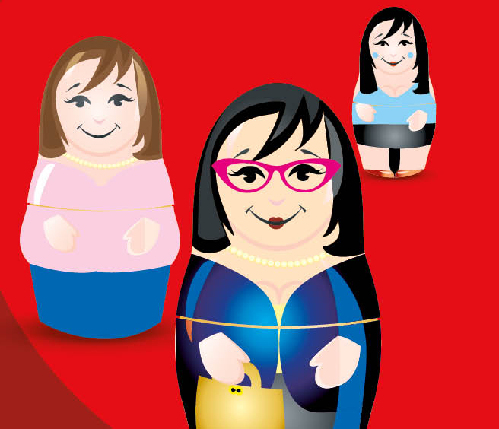|

According to Leymah Gbowee, one of this year's Nobel Peace Prize winners, violence is the biggest problem facing women today. For the Liberian activist, this includes not only sexual violence, domestic violence, or physical violence in war zones, but also how women are objectified in the media. Song Meifeng, an editor at the Norstar Media & Communications Inc., and Vimbayi Kajese, a Zimbabwean news presenter on China's CCTV-9 channel, explain the dynamics of objectification in their home countries.
Three Images
by Song Meifeng
If you are male, visualize an image of your ideal wife; if you are a female, visualize your ideal self. Most likely the picture is the same: young and beautiful, blessed with a great career but also happy to do housework. It's a perfect image. But it's also fiction borne out of advertising.
We are surrounded by ads – on the Internet, on TV, at the movies, even on mobile phones. According to researchers, a man in the United States on average sees 1,600 ads a day. They are omnipresent and their influence is subtle and powerful. There are three kinds of women featured in Chinese advertising.
The first type is the traditional woman, simple and unsophisticated. She is gentle and motherly, often next to a washing machine or a stove and happy about it. This image has existed in advertising for a long time, and encourages the idea that women take care of family members and belong to families.
The second type is the romantic woman, young and dreamy. Very often, she appears in ads for clothing, shampoo, jewelry and so on. She is charming, beautiful and affectionate, always with a handsome guy by her side. She is an object for the man to appreciate; her confidence is based on her appearance and the man's admiration.
The third type is the career woman. Her image is often used to sell office products. She appears to be mature, independent and makeup-free. She is always single.
These images can have a negative influence on women in real life. They set a standard for hairstyle, weight and posture. Women can end up paying more attention to their appearance than necessary. At the same time, men begin to assume the advertising standard is normal when perhaps it is not.
The images create a kind of social pressure. Although they disseminate three types of women, these three effectively cancel each other out. Hence, the career woman is always considered by men as undesirable, but the traditional woman lacks vitality. Only women who are wealthy but carefree are worthy of admiration. These images rob women of their individuality, and promote unrealistic ideas in men.
But things have begun to change. More women are educating themselves. In recent years, media literacy is garnering more attention in China. As the concept gains hold, people will gradually have a better understanding of advertising's power.
Outsourced Objectification
by Vimbayi Kajese
Zimbabwe's media portrays "womyn" in certain stereotypical roles. I say "womyn," an alternative spelling for woman/women that I was introduced to over a decade ago, because it disempowers stereotypes and objectification. Still, objectification in Zimbabwe is not the same as in Western or Chinese media. It's outsourced.
There are two reasons for this. First, overt sexualization in Zimbabwe is frowned upon in the media, which is government controlled. At recent auto show in Harare, female models parading around in shorts caused an uproar. Second, Zimbabwe's economy is still developing. It takes a certain level of GDP to professionally sell female sexuality. Honestly, we don't have the resources. We can't afford to airbrush, so we take our womyn as they are.
Media objectification that affects Zimbabwean womyn and men comes from abroad. However, this requires satellite ownership – a privilege for only a small percentage of the middle and upper classes. Until recently, there weren't many black families that could afford such luxury. When I was in high school, girls with eating disorders like anorexia usually had access to foreign media; their afflictions were primarily seen as "white girl problems."
Sexual objectification creeps in. On flyers for concerts and the like, scantily-clad womyn are risqué in their poses. But again, these are not local womyn. The ads are superimposed images of famous artists with no connection to the event.
I first became aware of this "outsourcing" in high school through a flyer for a club event. On it, a womyn was squatting in tight pants. It was going to be a raunchy party. I wondered who the girl was, and no one knew. It and other flyer images, I discovered later, were pictures from overseas album covers, magazines or still shots from music videos. Needless to say, the flyers dictate the dress code at these gigs – and more importantly the type of men and behaviors that follow.
Some marketing campaigns go "mainstream" by showcasing one type of womyn: thin, light skinned, with chemically-straightened hair. But the campaigns are unsuccessful in enforcing this ideal. Size, to us, is relative to health and wealth. If a womyn is too thin, she might have HIV/AIDS. But if a man is fat, it means he's eating well.
Regardless, there has been progress in how womyn are represented in Zimbabwe's media. Now in business ads they are bosses, board members and bankers, not just note takers. This emerging generation of media creators will be more enlightened than the last, not trapped in the cycle of patriarchal psychology: they will be womyn. |